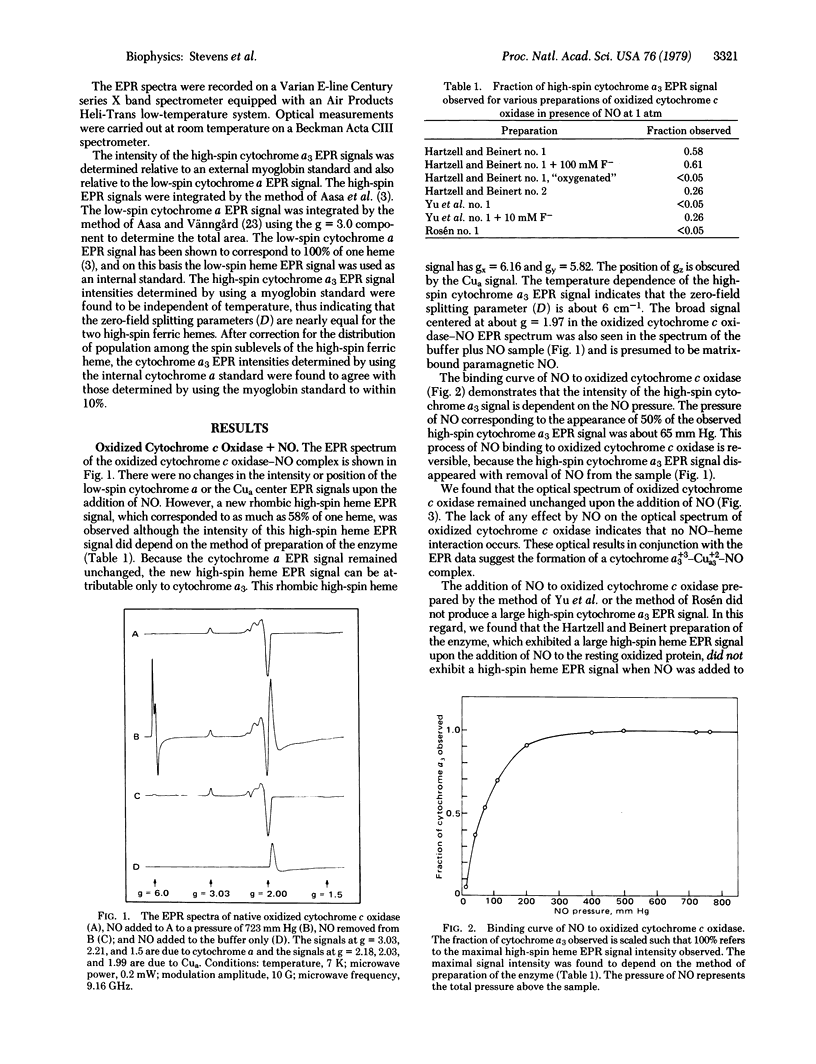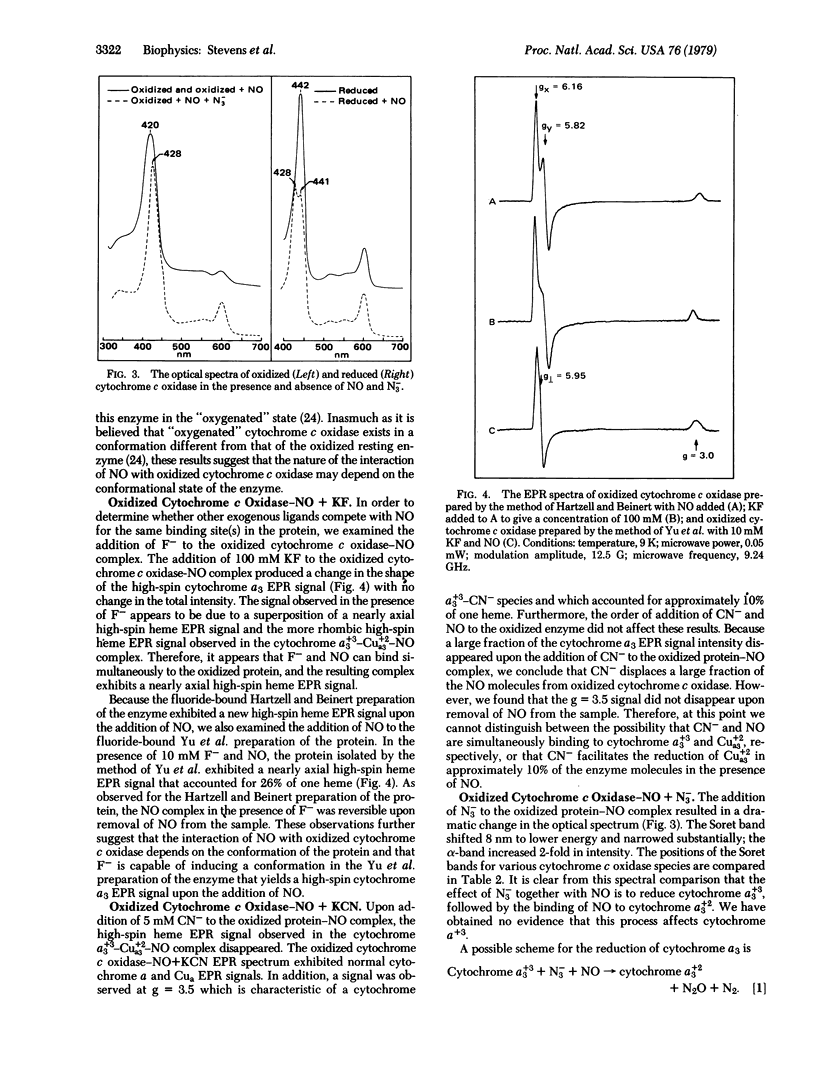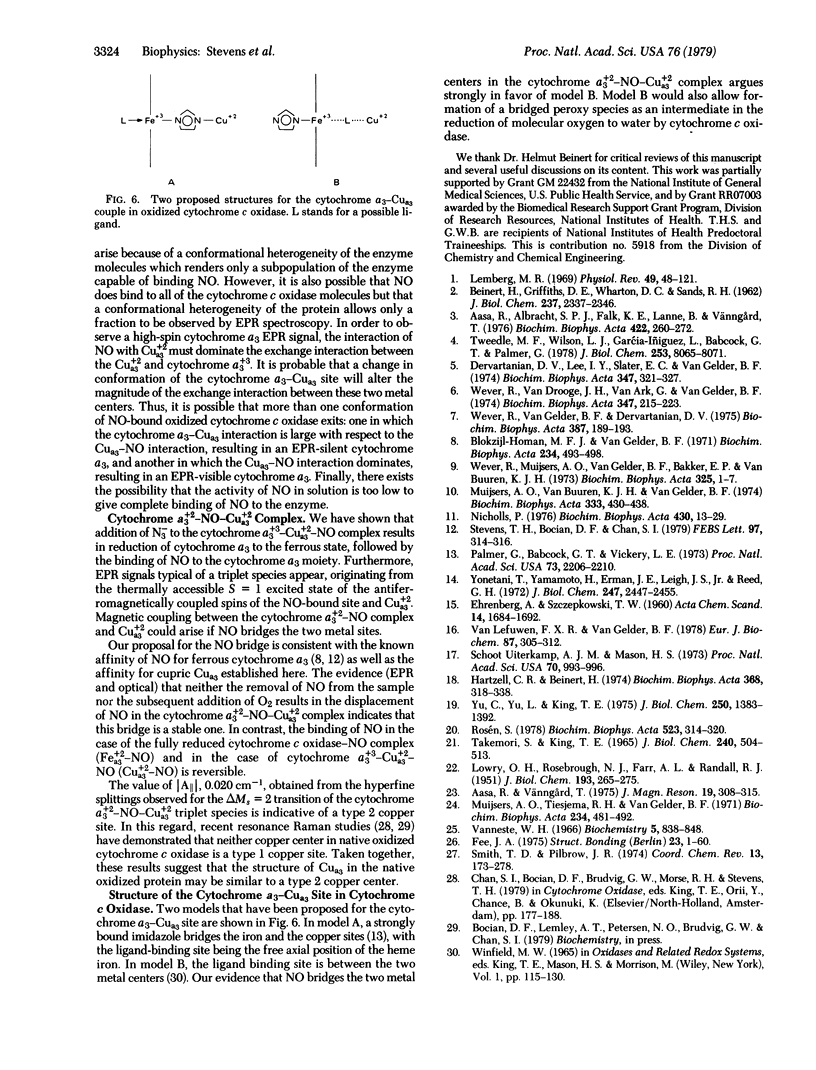Abstract
The addition of NO to oxidized cytochrome c oxidase (ferrocytochrome c:oxygen oxidoreductase, EC 1.9.3.1) causes the appearance of a high-spin heme electron paramagnetic resonance (EPR) signal due to cytochrome a3. This suggests that NO coordinates to Cu+2a3 and breaks the antiferromagnetic couple by forming a cytochrome a+33-Cu+2a3-NO complex. The intensity of the high-spin cytochrome a3 signal depends on the method of preparation of the enzyme and maximally accounts for 58% of one heme. The effect of N-3 on the cytochrome a+33-Cu+2a3-NO complex is to reduce cytochrome a3 to the ferrous state, and this is followed by formation of a new complex that exhibits EPR signals characteristic of a triplet species. On the basis of optical and EPR results, a NO bridge between cytochrome a+23 and Cu+2a3 is proposed--i.e., cytochrome a+23-NO-Cu+2a3. The half-field transition observed at g = 4.34 in the EPR spectrum of this triplet species exhibits resolved copper hyperfine splittings with [A+2] = 0.020 cm-1, indicating that the Cu+2a3 in the cytochrome a+23-NO-Cu+2a3 complex is similar to a type 2 copper site.
Full text
PDF




Selected References
These references are in PubMed. This may not be the complete list of references from this article.
- Aasa R., Albracht P. J., Falk K. E., Lanne B., Vänngard T. EPR signals from cytochrome c oxidase. Biochim Biophys Acta. 1976 Feb 13;422(2):260–272. doi: 10.1016/0005-2744(76)90137-6. [DOI] [PubMed] [Google Scholar]
- BEINERT H., GRIFFITHS D. E., WHARTON D. C., SANDS R. H. Properties of the copper associated with cytochrome oxidase as studied by paramagnetic resonance spectroscopy. J Biol Chem. 1962 Jul;237:2337–2346. [PubMed] [Google Scholar]
- Blokzijl-Homan M. F., van Gelder B. F. Biochemical and biophysical studies on cytochrome aa 3 . 3. The EPR spectrum of NO-ferrocytochrome a 3 . Biochim Biophys Acta. 1971 Jun 15;234(3):493–498. doi: 10.1016/0005-2728(71)90215-5. [DOI] [PubMed] [Google Scholar]
- Dervartanian D. V., Lee I. Y., Slater E. C., van Gelder B. F. Effects of ATP, antimycin and cyanide on the EPR spectra of cytochromes in phosphorylating submitochondrial particles. Biochim Biophys Acta. 1974 May 22;347(2):321–327. doi: 10.1016/0005-2728(74)90056-5. [DOI] [PubMed] [Google Scholar]
- Hartzell C. R., Beinert H. Components of cytochrome c oxidase detectable by EPR spectroscopy. Biochim Biophys Acta. 1974 Dec 19;368(3):318–338. doi: 10.1016/0005-2728(74)90178-9. [DOI] [PubMed] [Google Scholar]
- LOWRY O. H., ROSEBROUGH N. J., FARR A. L., RANDALL R. J. Protein measurement with the Folin phenol reagent. J Biol Chem. 1951 Nov;193(1):265–275. [PubMed] [Google Scholar]
- Lemberg M. R. Cytochrome oxidase. Physiol Rev. 1969 Jan;49(1):48–121. doi: 10.1152/physrev.1969.49.1.48. [DOI] [PubMed] [Google Scholar]
- Muijsers A. O., Tiesjema R. H., van Gelder B. F. Biochemical and biophysical studies on cytochrome aa 3 . II. Conformations of oxidized cytochrome aa 3 . Biochim Biophys Acta. 1971 Jun 15;234(3):481–492. doi: 10.1016/0005-2728(71)90214-3. [DOI] [PubMed] [Google Scholar]
- Muijsers A. O., Van Buuren K. J., Van Gelder B. F. Biochemical and biophysical studies on cytochrome oxidase. XV. Reaction with fluoride. Biochim Biophys Acta. 1974 Mar 26;333(3):430–438. doi: 10.1016/0005-2728(74)90127-3. [DOI] [PubMed] [Google Scholar]
- Nicholls P. The effect of formate on cytochrome aa3 and on electron transport in the intact respiratory chain. Biochim Biophys Acta. 1976 Apr 9;430(1):13–29. doi: 10.1016/0005-2728(76)90218-8. [DOI] [PubMed] [Google Scholar]
- Palmer G., Babcock G. T., Vickery L. E. A model for cytochrome oxidase. Proc Natl Acad Sci U S A. 1976 Jul;73(7):2206–2210. doi: 10.1073/pnas.73.7.2206. [DOI] [PMC free article] [PubMed] [Google Scholar]
- Rosén S. Purification of beef-heart cytochrome c oxidase by hydrophobic interaction chromatography on octyl-Sepharose CL-4B. Biochim Biophys Acta. 1978 Apr 12;523(2):314–320. doi: 10.1016/0005-2744(78)90034-7. [DOI] [PubMed] [Google Scholar]
- Stevens T. H., Bocian D. F., Chan S. I. EPR studies of 15NO-ferrocytochrome alpha3 in cytochrome c oxidase. FEBS Lett. 1979 Jan 15;97(2):314–316. doi: 10.1016/0014-5793(79)80110-6. [DOI] [PubMed] [Google Scholar]
- TAKEMORI S., KING T. E. EFFECT OF ALKALI AND BOROHYDRIDE ON CARDIAC CYTOCHROME OXIDASE. FORMATION OF SCHIFF BASE. J Biol Chem. 1965 Jan;240:504–513. [PubMed] [Google Scholar]
- Tweedle M. F., Wilson L. J. Electronic state of heme in cytochrome oxidase III. The magnetic susceptibility of beef heart cytochrome oxidase and some of its derivatives from 7-200 K. Direct evidence for an antiferromagnetically coupled Fe (III)/Cu (II) pair. J Biol Chem. 1978 Nov 25;253(22):8065–8071. [PubMed] [Google Scholar]
- Uiterkamp A. J., Mason H. S. Magnetic dipole-dipole coupled Cu(II) pairs in nitric oxide-treated tyrosinase: a structural relationship between the active sites of tyrosinase and hemocyanin. Proc Natl Acad Sci U S A. 1973 Apr;70(4):993–996. doi: 10.1073/pnas.70.4.993. [DOI] [PMC free article] [PubMed] [Google Scholar]
- Vanneste W. H. The stoichiometry and absorption spectra of components a and a-3 in cytochrome c oxidase. Biochemistry. 1966 Mar;5(3):838–848. doi: 10.1021/bi00867a005. [DOI] [PubMed] [Google Scholar]
- Wever R., Muijsers A. O., van Gelder B. F., Bakker E. P., van Buuren K. J. Biochemical and biophysical studies on cytochrome c oxidase. XI. Reaction with azide. Biochim Biophys Acta. 1973 Oct 19;325(1):1–7. doi: 10.1016/0005-2728(73)90144-8. [DOI] [PubMed] [Google Scholar]
- Wever R., van Drooge J. H., van Ark G., van Gelder B. F. Biochemical and biophysical studies on cytochrome c oxidase. XVII. An epr study of the photodissociation of cytochrome a32+-CO. Biochim Biophys Acta. 1974 May 22;347(2):215–223. doi: 10.1016/0005-2728(74)90046-2. [DOI] [PubMed] [Google Scholar]
- Wever R., van GELDER B. F., Dervartanian D. V. Biochemical and biophysical studies on cytochrome c oxidase. XX. Reaction with sulphide. Biochim Biophys Acta. 1975 May 15;387(2):189–193. doi: 10.1016/0005-2728(75)90102-4. [DOI] [PubMed] [Google Scholar]
- Yonetani T., Yamamoto H., Erman J. E., Leigh J. S., Jr, Reed G. H. Electromagnetic properties of hemoproteins. V. Optical and electron paramagnetic resonance characteristics of nitric oxide derivatives of metalloporphyrin-apohemoprotein complexes. J Biol Chem. 1972 Apr 25;247(8):2447–2455. [PubMed] [Google Scholar]
- Yu C., Yu L., King T. E. Studies on cytochrome oxidase. Interactions of the cytochrome oxidase protein with phospholipids and cytochrome c. J Biol Chem. 1975 Feb 25;250(4):1383–1392. [PubMed] [Google Scholar]
- van Leeuwen F. X., van Gelder B. F. A spectroscopic study of nitric-oxide-treated ceruloplasmin. Eur J Biochem. 1978 Jun 15;87(2):305–312. doi: 10.1111/j.1432-1033.1978.tb12379.x. [DOI] [PubMed] [Google Scholar]


